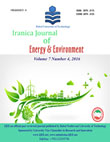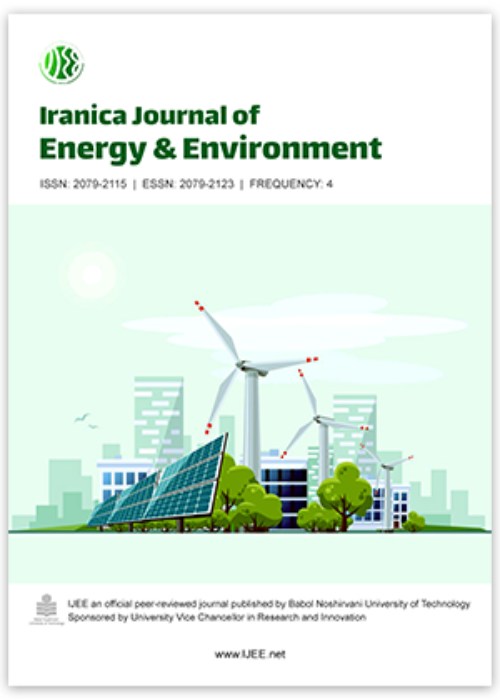فهرست مطالب

Iranica Journal of Energy & Environment
Volume:9 Issue: 1, Winter 2018
- تاریخ انتشار: 1397/02/24
- تعداد عناوین: 10
-
-
Page 1Parabolic trough power plants have been developed on several concepts for production of renewable energy in integrated solar combined cycle system (ISCCS) and direct steam generation (DSG). Each concept has their characteristic due to solar energy configuration. Recently, technology for Solar aided power generation (SAPG) is appeared for optimization of these concepts by solar contribution system in hybrid power plants. The aim of this work is thermodynamic analysis on solar hybrid power plants system for ISCCS and DSG concepts. For these concepts, we evaluated the main differences in solar efficiency to electrical power. The solar aided power generation was proposed for evaluating the solar contribution in DSG concept. The study shows that the share of solar contribution in DSG concept is high, for the best method on thermal solar extraction in the DSG concept. Therefore, the optimum value of solar extraction is to preheat the feed water in the heater.These models were evaluated in this work which is simulated on TRNSYS software and System Advisor Model (SAM). The analysis in performance of hybrid concepts and solar contribution in new DSG concept can be evaluated. It was found the best method is solar contribution in the solar hybrid power plants.Keywords: Hybrid power plants, Integrated concept, Solar energy, Power generation
-
Page 10This study used a simulate based approach for calculating building energy consumption using monitoring data. This calibration was carried out on a building situated in Gurgaon, Delhi. Software used for dynamic simulation was E-Quest 3.65. The objective function was set to minimize the difference between calculated data and simulated data. The evaluation of the model accuracy, the mean bias error (MBE) and the Coefficient of Variation (Cv RMSE) were calculated. Through this paper show the real behavior of people in a building simulation, there may be differences up to 30% [1]. This paper shows the possibility of energy, money and time saving. The schedule of simulated building is same as per actual building.Keywords: Energy saving. Software, Building energy simulation, Energy conservation measure, Energy efficiency improvement
-
Page 16In this paper, the effect of stall delay on distribution of normal forces in different sections of rotor are studied by an enhanced version of the blade element momentum theory (BEM), based on the 3D correction Chaviaropoulos and Hansen mode. This model is computed at wind speed of 24m/s under the yaw angle 15◦. It is found that the BEM calculation on the outer (the radial distance more than 35% spanwies) spanwise is more trustable than inner spanwise. At 60, 82 and 92% spans, the 3D correction does not affect the output result and stall does not occur. Relative velocity rose dramatically at 25 and 35% spans, consequently angle of attack increased too particularly between azimuth angles from 270◦ up to 90◦. In this regions, stall phenomena are happened. Also it is found that the 3D correction has the maximum effect on 35 and 25% spans. The maximum improvement is 99.57% at 35% section and the azimuth angle 121◦.Keywords: Wind Turbine, Yaw Angel, Blade Element Momentum Theory, 3D Correction
-
Page 24The photovoltaic (PV) Power generation is the best source of renewable energy due to advantages such as free fuel cost, cleanness, little maintenance, and causing no noise due to absence of moving parts. Egyptian government moves towards encourage consumers to generate electricity from PV array and issues new electricity law that allow consumers to sell the surplus of the generated power of PV to utility. Partial shading is one of the obstacles of the propagation of the electricity generation by PV array. Partial shading may be occurs due to clouds, trees and neighbor building. This paper propose a new method for optimization of power of a rooftop photovoltaic (PV) array connected to grid under partial shading. This work provides a comparative literature review on methods to mitigate these effects and the drawbacks of this method. This paper represent the components of the interconnection between the rooftop PV array and the grid. The Maximum power point (MPP) achieved by perturb and observe technique which control the duty cycle of the buckboost converter. The proposed technique increased the output power of the PV and output efficiency during the partial shading condition.Keywords: Partial shading, Cascaded DC-DC converter, MATLAB Simulink, rooftop photovoltaic array, Grid photovoltaic
-
Page 31Nickel titanium oxide (NiTiO3) nanoparticles were synthesized at low temperature in non aqueous medium by modified Pechini method using ethylene glycol and citric acid as polymeric precursors. The structural and morphological characteristics of the products were studied by X-ray diffraction, fourier transform infrared spectroscopy (FT-IR), UV-Visible diffuse reflectance spectroscopy (UV-DRS), scanning electron microscope (SEM) and energy dispersive X-ray spectroscopy (EDAX). XRD patterns of powder revealed crystalline rhombohedral NiTiO3 obtained at 700 o C and this crystalinity increased with temperature. SEM images estimated that the grain sizes of NiTiO3 to be in the range 10250 nm. DRS spectra reveal two peaks, one at around 440-450 nm and another one at around 740-750 nm. The band gap energy was calculated using Tauc plot and it was found to be 1.67 eV. In this study, photocatalytic properties of NiTiO3 on sulfamethoxazole drug degradation was investigated which has not been reported elsewhere and results shows that it is a prominent material for photodegradation of drug in the range of visible light.Keywords: Pechini synthesis, NiTiO3, Photodegradation, Sulfamethoxazole
-
Page 41Calendula officinalis is a low-cost material used as adsorbent for the removal of textile dye, Brown HE-2G. The effect of pH, concentration of dyes, adsorbent dose and contact time were obtained by batch adsorption technique. The results were analyzed by adsorption isotherm models (Freundlich, Langmuir, RedlichPeterson and Tempkin). The results were in good agreement with Langmuir model and the Redlich-Peterson isotherm models. The Langmuir monolayer adsorption quantity was found to be, 76.56 mg g-1 Brown HE-2G. Pseudo-first-order, pseudo-second-order, Intraparticle diffusion and Tempkin kinetic models were used to fit the experimental data, it was well fitted into pseudo second order kinetics. FT-IR and SEM analysis have effectively supported the adsorption of Brown HE2G on the adsorbent.Keywords: Calendula officinalis, Brown HE-2G, Textile dye, Adsorption kinetics
-
Page 48Phytoremediation is a process which utilizes plants to remove contaminants from the environment. It is the latest alternative to treatment technique that needs to identify potential plants and their ability to resist toxicity of contaminants before a full scale system can be installed to ensure that the remedy is effective by the selected plants. The aim of this study is to evaluate the ability of two native plants in Malaysia, Ludwigia octovolvis and Phragmites karka, to survive when exposed to real crude oil sludge. The experiment was performed in a greenhouse for 15 days. The observation was made three times a week. The plants were also watered using tap water to ensure the plants could grow. After 15 days of observation, the two plant species had shown that they could grow and survive in pots with 100% of crude oil sludge. From this preliminary test, L. octovolvis and P. karka showed their initial ability to treat sand contaminated with crude oil sludge. As a conclusion, both native plants have the potential in the phytoremediation process of hydrocarbon and will be used in future prolonged phytoremediation of crude oil sludge.Keywords: Crude oil sludge, Ludwigia octovalvis, phytotoxicity, Phytoremediation, Phragmites karka
-
Page 52Polychlorinated biphenyls (PCBs) are a health risk for high trophic level predators and the Stockholm Convention requires measures to reduce or eliminate their release into the environment. The study was conducted an ecological survey on River Ogun, Lagos, Nigeria, quarterly over a period of two years (March 2013-February 2015). Water physicochemistry and the levels of nine PCB congeners were analyzed in water and sediment samples from five river zones: Agboyi, Maidan, Owode Elede, Kara, and Akute. Water physicochemistry showed significant (pKeywords: Polychlorinated biphenyl congeners, Environmental contamination, Physicochemistry, Ogun River
-
Page 64The main focus of present study was to demonstrate the possible generation sources of metal contamination in soil. The only authorized waste disposal site at Rajbandh located at Khulna in Bangladesh. To this endeavors, total sixty soil samples were collected at a depth of 0-30 cm from the existing ground surface and the relevant metal elements of Al, As, Ba, Ca, Cd, Cr, Co, Cu, Fe, Hg, K, Mn, Na, Ni, Pb, Sb, Sc, Sr, Ti, V and Zn were measured through standard methods in laboratory. Desired results for normality test obtained from normal QQ plot using XLSTAT. Almost all the metal elements were normally distributed in both the seasons. Multivariate statistics such as Pearsons correlation, principal component analysis (PCA) and agglomerative hierarchical clustering (AHC) were performed using XLSTAT to show the correlation between metal elements and their possible generation sources. Results of multivariate statistics revealed that almost all the metal elements were strongly correlated indicating same generation sources. In addition, results of PCA and AHC depicted that almost all the metal elements in soil derived from anthropogenic/human activities; least number of metal elements from natural sources as well as from both the natural and anthropogenic sources. Proper identification and control of possible generation sources of metal elements may reduce the threat of soil contamination due to metal elements in waste disposal site.
Keywords: Waste disposal site, Nonparametric test, Normal QQ plot, Conventional statistics, Multivariate statistics, Anthropogenic source -
Page 71The present paper describes analytical optimization and numerical simulation of a modern hydro-kinetic turbine. It was a tidal turbine with twin elliptic-rotors. The turbines were installed within the twin ducts inside of a tidal dam. There was a gap between each of the turbines and the ducts for allowing vortex formation around each of turbines. The pitch angle distribution was optimized for highest energy extraction from water flow. The numerical simulations of the turbine have shown great power-coefficient that exceeds from 1.0 for tip-speed ratios greater than 3.5. According to power-coefficient curve, the runaway speed for the hydrokinetic turbine was eliminated and the extracted power has increased with a second order function at higher tip-speed ratios. Based on obtained data, an axial hydro-kinetic turbine can not only absorb flow kinetic energy of incoming flow, but also can extract energy from parallel flows over each turbine. The powercoefficient curve against tip-speed ratio encounters with a break point around tip-speed ratio of 3.0. Simultaneously a strong vortex ring has formed around each of turbines. Flow trajectories illustrate how the hydro-kinetic turbine was able to absorb much more energy from external flows than conventional axial hydro-kinetic turbines.Keywords: Energy resource, Power-coefficient, Renewable energy, Shape optimization, Tidal turbine


